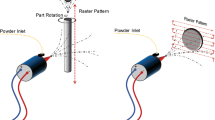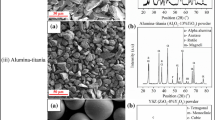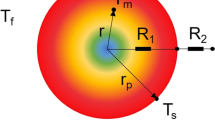Abstract
Vacuum chambers used in high-energy particle accelerator experiments are conventionally made of bulk beryllium, which shows significant drawbacks due to cost and toxicity. An alternative solution could be to develop chambers made of polymer-based composites. Since these materials exhibit high outgassing not compatible with an ultra-high vacuum environment, a suitable gas-tight coating is required. Cold spray deposition of aluminum can be a solution, provided that the coating behaves as a perfect vacuum barrier. Porosity, especially percolating porous networks, is key to coating gas tightness issues. This work addresses the relationship between porosity and gas-tightness in cold spray coatings. To do so, coatings with different porosity were achieved playing with powder morphology, composition, and process parameters. Their gas tightness was evaluated by helium leak tests. Classical microscopy, being essentially a 2D analysis, is strongly limited when dealing with 3D properties as porosity percolation. For this reason, 3D X-ray microtomography images of coatings were obtained and treated by image analysis methods: pores were compared in terms of size and shape. Overall porosity properties, including percolation and a homogeneity criterion, were also investigated. Percolating porosity was highlighted for several samples which showed poor gas-tightness properties. The permeability of percolating pore structures was then numerically computed by a fast Fourier transform-based method, to quantify the mass flow through the coating. Results of those computations were finally compared to experimental coating leak rate measurements, in an effort to elucidate the link between gas tightness and morphology of the pore space.




















Similar content being viewed by others
References
Abdallah, B., Willot, F., Jeulin, D.: Stokes flow through a Boolean model of spheres: representative volume element. Transp. Porous Media 109(3), 711–726 (2015)
AFNOR. Nf en 573-1, Jul 2020 (Online; Accessed 15. Jul 2020)
Anderson, J.: Fundamentals of Aerodynamics, 4th edn. McGraw-Hill Science/Engineering/Math (2004)
Beucher, S.: Watershed, hierarchical segmentation and waterfall algorithm. In: Mathematical Morphology and its Applications to Image Processing, pp. 69–76. Springer (1994)
Blochet, Q., Delloro, F., N’Guyen, F., Jeulin, D., Borit, F., Jeandin, M.: Effect of the cold-sprayed aluminum coating-substrate interface morphology on bond strength for aircraft repair application. J. Therm. Spray Technol. 26(4), 671–686 (2017)
Bondi, A.: van der Waals volumes and radii. J. Phys. Chem. 68(3), 441–451 (1964)
Chen, C., Yan, X., Xie, Y., Huang, R., Kuang, M., Ma, W., Zhao, R., Wang, J., Liu, M., Ren, Z., Liao, H.: Microstructure evolution and mechanical properties of maraging steel 300 fabricated by cold spraying. Mater. Sci. Eng. A 743, 482–493 (2019)
Engelmann, G., Genet, M., Wahl, W.: Vacuum chambers in composite material. J. Vac. Sci. Technol. A 5(4), 2337–2341 (1987)
Faessel, M.: Licence simple morphological image library (2019)
Feng, S., Wang, C., Ma, B., Ling, G., Zheng, Z.: Study on Effects of Heat Treatment on Morphology of Al Coating on the Surface of Mg Alloy by Cold Spray. Atlantis Press, The Netherlands (2012)
Garion, C.: New materials for vacuum chambers in high energy physics. World J. Mech. 4(3), 71–78 (2014)
Gavras, A.G., Lados, D.A., Champagne, V.K., Warren, R.J.: Effects of processing on microstructure evolution and fatigue crack growth mechanisms in cold-spray 6061 aluminum alloy. Int. J. Fatigue 110, 49–62 (2018)
Hadjiconstantinou, N.G.: The limits of Navier-Stokes theory and kinetic extensions for describing small-scale gaseous hydrodynamics. Phys. Fluids 18(11), 111301 (2006)
Hassani, M., Veysset, D., Victor, C., Jr., Nelson, K., Schuh, C.: Adiabatic shear instability is not necessary for adhesion in cold spray. Acta Mater. 158 (2018)
Ierardi, V., Becker, U., Pantazis, S., Firpo, G., Valbusa, U., Jousten, K.: Nano-holes as standard leak elements. Measurement 58, 335–341 (2014)
Jeandin, M., Delloro, F., Léger, P., Bortolussi, V., Sennour, M.: Cold spray under the banner of thermal spray in the whirlwind of additive manufacturing. Surf. Eng. 941, 1–6 (2018)
Khomutov, M., Chereshneva, A., Petrovskiy, P., Daubarayte, D., Cheverikin, V., Sova, A., Travyanov, A., Smurov, I.: Microstructure of Al–Mg–Sc–Zr alloy cold spray deposits after heat treatment and hot isostatic pressing. J. Alloys Compd. 157644 (2020)
King, P.C., Zahiri, S., Jahedi, M., Friend, J.: Aluminium coating of lead zirconate titanate—a study of cold spray variables. Surf. Coat. Technol. 205(7), 2016–2022 (2010)
King, P.C., Zahiri, S.H., Jahedi, M.: Microstructural Refinement within a cold-sprayed copper particle. Metall. Mater. Trans. A 40(9), 2115–2123 (2009)
Leger, P.E., Sennour, M., Delloro, F., Borit, F., Debray, A., Gaslain, F., Jeandin, M., Ducos, M.: Multiscale experimental and numerical approach to the powder particle shape effect on al-al2o3 coating build-up. J. Therm. Spray Technol. 26(7), 1445–1460 (2017)
Maali, A., Colin, S., Bhushan, B.: Slip length measurement of gas flow. Nanotechnology 27(37), 374004 (2016)
Maurer, J., Tabeling, P., Joseph, P., Willaime, H.: Second-order slip laws in microchannels for helium and nitrogen. Phys. Fluids 15(9), 2613–2621 (2003)
Moridi, A., Hassani-Gangaraj, S.M., Guagliano, M.: A hybrid approach to determine critical and erosion velocities in the cold spray process. Appl. Surf. Sci. 273, 617–624 (2013)
Neuberger, H., Hernandez, F., Rey, J., Bonk, S., Rieth, M., Koch, J., Schmalisch, B., Müller, O., Volker, K.-U., Volker, D., Leyh, S., Niewöhner, R., Brenner, A.: Fabrication of HCPB breeding blanket components using the additive manufacturing processes of selective laser melting and cold spray. Fusion Eng. Des. 160, 112026 (2020)
Ngai, S., Ngai, T., Vogel, F., Story, W., Thompson, G.B., Brewer, L.N.: Saltwater corrosion behavior of cold sprayed AA7075 aluminum alloy coatings. Corros. Sci. 130, 231–240 (2018)
Qiu, X., ul Haq Tariq, N., Qi, L., Tang, J.-R., Cui, X.-Y., Du, H., Wang, J.-Q., Xiong, T.-Y.: Influence of particulate morphology on microstructure and tribological properties of cold sprayed a380/al2o3 composite coatings. J. Mater. Sci. Technol. 44, 9–18 (2020)
Raletz, F., Vardelle, M., Ezo’o, G.: Critical particle velocity under cold spray conditions. Surf. Coat. Technol. 201(5), 1942–1947 (2006) (The 2nd International Meeting on Thermal Spraying)
Sebastien, W., Delloro, F., Jeandin, M., Debray, A., Garion, C., Galsin, F., Sennour, M.: Cold spray as an innovative process to develop ultrahigh vacuum gas-tight aluminum coatings for applications in a large particle collider (2019) (Accessed 17 Dec 2020)
Serra, J.: Introduction to mathematical morphology. Comput. Vis. Graph. Image Process. 35(3), 283–305 (1986)
Slattery, J.C.: Flow of viscoelastic fluids through porous media. AIChE J. 13(6), 1066–1071 (1967)
Sutton, G.P., Ross, D.M.: Rocket Propulsion Elements: An Introduction to the Engineering of Rockets. John Wiley & Sons Inc, Hoboken, NJ, USA (1992)
Triantou, K.I., Pantelis, D.I., Guipont, V., Jeandin, M.: Microstructure and tribological behavior of copper and composite copper+alumina cold sprayed coatings for various alumina contents. Wear 336–337, 96–107 (2015)
Wang, Q., Niu, W., Li, X., Han, P., Mao, X., Yang, J., Zhang, M.-X.: Tuning the microstructure and mechanical properties of additive manufactured aluminum matrix composites by cold spray. Surf. Coat. Technol. 428, 127847 (2021)
Wang, Y., Adrien, J., Normand, B.: Porosity characterization of cold sprayed stainless steel coating using three-dimensional X-ray microtomography. Coatings 8(9), 326 (2018)
Whitaker, S.: The Method of Volume Averaging. Springer, Netherlands (1999)
Wiegmann, A.: Computation of the Permeability of Porous Materials from Their Microstructure by FFF-Stokes. Berichte des Fraunhofer ITWM 129 (2007)
Willot, F., Abdallah, B., Jeulin, D.: The permeability of boolean sets of cylinders (2016)
Zahiri, S., Mayo, S., Jahedi, M.: Characterization of cold spray titanium deposits by X-ray microscopy and microtomography. Micros. Microanal. 14, 260–6, 07 (2008)
Acknowledgements
The authors wish to acknowledge the MATMECA consortium available at the École Centrale/Supélec for the FIB facility.
Author information
Authors and Affiliations
Corresponding author
Ethics declarations
Declarations
The authors declare that they have no known competing financial interests or personal relationships that could have appeared to influence the work reported in this paper.
Additional information
Publisher's Note
Springer Nature remains neutral with regard to jurisdictional claims in published maps and institutional affiliations.
Appendix A: Stokes flow conditions
Appendix A: Stokes flow conditions
Determining the flow regime of a fluid allows its behavior to be modeled according to the nature of the interactions that predominate and act on its evolution: for this purpose, dimensionless numbers are used involving characteristic quantities of the medium, whether physical (temperature, density, etc.) or geometric (characteristic size). The flow regime can refer to the continuous or discrete nature of the behavior of a fluid, but also to the behavior of its flow lines (laminar, transient, turbulent). The simplest flows to consider from a mathematical point of view are Stokes flows: they are continuous, laminar, and in steady state (Anderson 2004).
To decide whether a flow is continuous or molecular, the Knudsen number \(K_n\) is used. Depending on its value, the flow is either continuous (the discrete and molecular nature of the fluid is ignored), molecular (the interaction between particles and wall surfaces are prevailing), or rarefied (the interaction between the particles must be governed statistically). This number is defined as follows:
With \(\lambda \) the mean free path of particles and d a representative length of the medium here taken as the inverse of the specific area \(\gamma ^{-1}\). If \(K_n < 0.01\), the Navier-Stokes equations can be used to describe the fluid continuously. Although not applicable beyond \(K_n = 0.1\), Hadjiconstantinou (2006) shows that they allow to approximate mean fields, in particular the fluid velocities. For \(0.01< K_n < 0.1\), conditions of fluid sliding on the walls (\({\mathbf {v}}_{wall}\)) should be taken into account. However, in the case of gaseous helium, this effect can be neglected up to \(K_n \le 0.3\) (Maurer et al. 2003; Maali et al. 2016).
Figure 21 shows the Knudsen number values for microstructures with percolating porosity, with T = 293 K, P = 101325 Pa and \(\delta \) = 140 pm, Van Der Waals radius of helium (Bondi 1964).
Here, \(K_n < 0.1\) and is on average equal to 0.022, and varies from 0.0075 to 0.0038, at the limit between the continuous and rarefied flow regimes. Nevertheless, the behavior of the fluid can be described using the Navier-Stokes equations, if we consider average quantities such as the velocity or pressure field (Hadjiconstantinou 2006).
The Naviers-Stokes equations can be simplified. For this purpose, the Reynolds number Re is introduced, which corresponds to the ratio between the inertial term \(\rho (\mathbf{u }.\nabla )\mathbf{u }\) and the viscous term \(\mu \nabla ^2 \mathbf{u }\) in a fluid. When Re \(\ll 1\), then the inertial term becomes negligible in front of the viscous term. In this case, the flow is laminar. It is expressed as follows:
With \(\rho \) the density of the fluid, v the speed of the fluid in the medium, L a characteristic quantity of the medium, here the inverse of the specific surface \(\gamma ^{-1}\) and \(\mu \) the dynamic viscosity.
The velocity was estimated as a function of the thicknesses e and morphological tortuosity \(\tau \) of the samples. It is assumed that the pore tortuosity of a sample is equal, as a first approximation, to the morphological tortuosity measured on the tomography images. If the sample has two percolating pores, the average of the two tortuosities is taken. The thicknesses were measured with a caliper. The Table 6 shows the tortuosities and thicknesses for each sample. In the case of E 2.5 350 20, a tortuosity equal to the average of the tortuosity of the other pores is taken, as the latter could not be measured. As the detector gives a quasi-instantaneous response, 1 s is taken as the value for calculating the velocity.
The speed of helium in a pore is then \(v = \frac{e \tau }{1}\).
Figure 22 shows the estimated Reynolds numbers for the samples presented in Table 6. All Reynolds values are \(\ll 1\), varying in the range \(10^{-4}--10^{-3}\). The inertial term can then be neglected over the viscous term and the flow can be considered as purely laminar.
The flow can also be considered is a steady state. In effect, during the leak experiments, each leak rate measurement was recorded after a certain time interval, so that the value was stable on the detector. Finally, the problem can be reduced to the following equation, corresponding to a Stokes flow:
Rights and permissions
About this article
Cite this article
Weiller, S., Francesco, D., François, W. et al. Influence of Porosity on Ultra-High Vacuum Gas-Tightness in Cold-Sprayed Aluminum Coatings. Transp Porous Med 144, 339–366 (2022). https://doi.org/10.1007/s11242-022-01806-3
Received:
Accepted:
Published:
Issue Date:
DOI: https://doi.org/10.1007/s11242-022-01806-3






